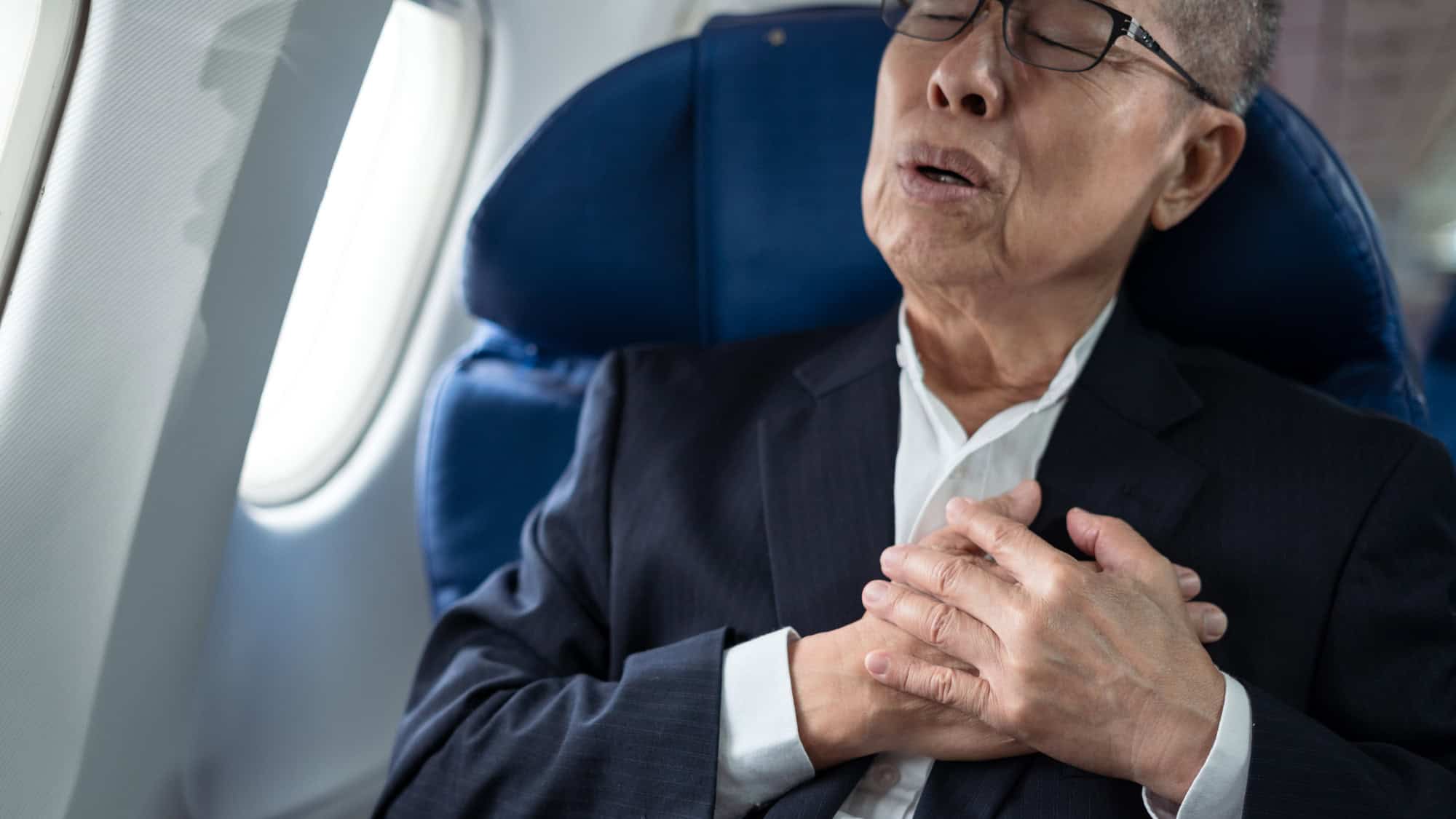Found By Accident contains affiliate links and is a member of the Amazon Services LLC Associates Program. If you make a purchase using one of the Amazon links (or other affiliate links), we may receive compensation at no extra cost to you. See our disclosure policy for more information.
11 Health Risks Of Flying Long Distances (And How To Avoid Them)
Flying long distances can be an adventure in itself, but let’s be real, spending hours packed in a metal tube hurtling through the skies does come with its drawbacks. Sure, you’re chasing exciting destinations and bucket-list experiences, but your body isn’t always as thrilled about the whole ordeal.
Between the cramped seats, recycled air, and time zone chaos, those long-haul flights can throw a few curveballs at your health. And while most people get through it with nothing more than a stiff neck and a craving for real food, there are some real risks that might require a bit of extra thought or preparation.
Don’t worry, we’re not here to scare you. We just think it’s a good idea to know what you might be dealing with before mastering the fine art of sleeping next to a stranger in economy class.
Risk: Deep Vein Thrombosis (DVT) And Pulmonary Embolism

The glamorous world of airborne travel: cramped seats, limited legroom, and the possibility of developing DVT. Talk about first-class perks, huh? Deep vein thrombosis happens when blood pools in your legs during those marathon flights, leading to clots that could cause trouble. Fun, right?
But don’t panic; there’s a survival kit for this. First, pick an aisle seat; your legs will thank you for the freedom to stretch and roam. Next, channel your inner fitness enthusiast with hourly calf pumps. Hydrate as if you’re preparing for a desert trek, and consider investing in proper graduated compression stockings.
If you’re a high-risk traveler, consult your health guru… better safe than clotty. Nobody needs a blood clot as their inflight companion.
Risk: Dehydration And Dry Mucous Membranes

The cabin air doesn’t just feel dry; it’s practically sipping on your will to stay hydrated. Between the recycled air and borderline desert-like humidity levels, dehydration can sneak up faster than flight attendants with drink carts.
Guzzle water like it’s a competition, and ease up on those in-flight cocktails unless you enjoy feeling like a human raisin. Caffeine? Same deal. If your nose feels like it’s on strike, a saline spray can get it back to work.
And for the love of comfort, pack lip balm and some lubricating eye drops to keep your face from cracking apart somewhere over the Atlantic. Pro tip? Start hydrating before the flight even begins. You’ll thank yourself when your lips don’t feel like sandpaper at touchdown.
Risk: Airborne Infections (Cold/Flu)

Airplanes might achieve miracles in travel, but they’re also a cozy conference room for germs. Want to dodge that airborne souvenir? Slap on some hand sanitizer like it’s your new fragrance.
Clean up the tray table, armrests, and whatever questionable surfaces you might touch because your immune system deserves a fighting chance. Contemplating a mask for extra protection? Smart move, especially when you’re in densely packed cabins with air-sharers who forgot tissues exist.
Cabin ventilation systems and HEPA filters do their best, but they’re not miracle workers. Oh, and keep your hands off your face unless you enjoy rolling the dice with colds. Hygiene first… air sickness bags second.
Risk: Diabetics having Blood-Sugar Swings

Flying with diabetes isn’t impossible, as long as you have the right plan and snacks. Definitely snacks. Keep your testing supplies, medications, and go-to nibbles in your carry-on. You don’t want to gamble on whether your checked bag makes it to the same continent as you.
Crossing time zones? Work out a dosing plan with your doctor so your insulin doesn’t rebel against changing schedules. And if chaos strikes, have a written plan people can follow.
Consider getting a medical ID. It’s like a “Get Out of Trouble Free” card for emergencies. Long-haul flights and unpredictable blood sugar don’t mix, but with some prep, you’ll handle it like a pro.
Risk: Back, Neck, And Shoulder Strain

Ever found yourself turning into a human pretzel in an airplane seat? Welcome to the world of back, neck, and shoulder strain. Those seats were not designed with long-term comfort in mind, more like “survive a few hours and good luck.”
To fight the inevitable aches and pains, grab a small lumbar support or even a rolled-up sweater (your lower back will be happier than a pig in mud). And change positions often, because sitting like a statue for hours is great for a wax museum, not your spine.
Don’t forget to stand up and stretch when you can, without awkwardly climbing over your neighbors. Keep your carry-ons light and close by. Hauling an overstuffed bag into the overhead bin while wedging your neck at a strange angle is an injury just waiting to happen.
Risk: Ear And Sinus Barotrauma

Airplane ear… also known as nature’s way of saying “feeling cozy, are we? Time for some pressure fun!” When those sudden altitude changes have your eardrums playing tug-of-war, it’s time to yawn, swallow, or try the gentle Valsalva maneuver (basically blowing through your nose while it’s pinched shut).
Short-acting decongestants can also be a lifesaver, but check if they’re right for you first. And here’s the golden rule of flying with a severe sinus or ear infection: don’t. Postpone the trip, and save yourself the agony of feeling like your head’s about to implode.
For everyone else? Chewing gum during takeoff and landing isn’t just for flavor; it keeps your jaw moving, which can help keep the pressure blues at bay.
Risk: UVA Exposure At Window Seats

Here’s a plot twist: sitting by the window during a daytime flight might not just give you scenic views; it could also give you a sunburn. Yup, those tiny windows don’t block all UVA rays, and cockpit studies have shown that meaningful UVA transmission is no joke.
Lower that shade when the sun is out in full force, and consider sunscreen if you’re taking a daytime flight. Sounds extra, but so is explaining a mysterious tan to your dermatologist.
Think of it as the airborne version of lounging poolside (minus the cocktail). It’s a small but smart precaution to save your skin in the long run, because squinting through glaring sunlight and collecting UV rays at 35,000 feet is officially overrated.
Risk: Cosmic Ionizing Radiation

Ever heard of cosmic ionizing radiation? It might sound like you’re gearing up to join a sci-fi movie, but it’s just those tiny doses of radiation you get while soaring through the skies. But before you start panicking, know this: the occasional traveler’s exposure is super low.
If you’re not constantly racking up miles or flying ultra-long-haul polar routes, you’re in the clear for the most part. However, for you frequent fliers, it might be worth minimizing those repeated high-latitude trips.
And for pregnant flyers, it’s a good idea to talk with your clinician just to cover all bases. Bottom line? Unless you’ve built your vacation plans around orbiting the North Pole, chances are this isn’t the risk on our list that should keep you up at night… jet lag will handle that nicely.
Risk: Dental Barotrauma

Flying isn’t all peanuts and pretzels; sometimes, it’s dental pain at 35,000 feet. If you’ve recently had a dental procedure, like a filling or root canal, or you’re harboring an unresolved tooth issue, brace yourself (pun intended).
The cabin’s low air pressure can mess with tiny air pockets trapped in your teeth, possibly leading to sharp pain that’ll make you regret skipping your dentist’s advice. So give your pearly whites some healing time before your sky-high adventure, or consult your dentist beforehand about how soon is too soon to board.
And if good oral hygiene isn’t already part of your travel prep, it’s time to level up. Nobody wants a mid-flight toothache ruining their dream getaway.
Risk: Heart And Lung Issues From Cabin Pressure

Cabin pressure at cruising altitude feels like hanging out at 6,000–8,000 feet above sea level, which, for most folks, is just a mild inconvenience.
But if your lungs or heart like to throw tantrums (thanks to severe COPD, anemia, or heart failure), it’s a bigger deal. Low oxygen levels can stress already struggling systems. So before you wing it, talk to your healthcare provider about in-flight oxygen or get medical clearance to ensure smooth sailing in the skies.
Also, PSA for those feeling invincible: running a marathon at altitude is hard, and so is demanding peak performance from your body mid-air. Plan ahead, stay comfy, and skip the heroics… you’ve got enough to worry about with that crammed middle seat.
Risk: Jet Lag

Jet lag is your body screaming, “What time is it?!” across time zones. Skipping continents might seem glamorous until you’re wide awake at 3 a.m., contemplating life in your hotel’s blackout-curtained abyss.
The trick? Gradually shift your sleep and eating schedule closer to the destination timetable before traveling. Bright light exposure? Use it strategically. The morning sun is your friend in some time zones, but an enemy in others.
Thinking of resetting with melatonin? Keep it low-dose and at the right time (ask Google or your doctor, not your cousin Karen). Oh, and caffeine and booze? Tempting, sure, but they’ll tag-team your circadian rhythm into chaos, so maybe don’t do it.
Like Our Content? Follow Us On MSN (or click the Follow Button above) to see more from Traveling In Focus.






